
New hotels face an uphill battle, struggling to go from zero to 60 mph upon opening with little to no brand awareness to help fuel the engine.
NB: This is an article from Tambourine
During these initial months, new hotels need all the marketing support they can get. A stream of customers acquired through email marketing, for example, would be a welcome sight.
Fortunately, there are a wide variety of tools and tactics to help shift email database growth into high gear.
Whether you represent a new hotel, or an existing property looking to rebuild its email list and ensure GDPR compliance, here are four proven ways to rapidly expand your customer database and get your email marketing up and running at full steam:
1. Get Aggressive With Your CTAs
Don’t be afraid to ask. Most established hotel sites have an email signup in the footer, but if your primary goal is to increase emails, hotels should get a bit more aggressive.
Displaying the call to action (CTA) for email subscriptions higher and more prominently on the page is a simple and highly effective way to boost email form conversions.
Don’t stop there. Consider the CTA itself and whether it’s appropriately enticing to make site visitors take that extra step. Some elements to build and customize within your CTA include:
- Exclusivity: Create a special offer that generates excitement for new email subscribers.
- Fear Of Missing Out (FOMO): Build a sense of urgency into the CTA, with offers that expire after a limited time.
- Personalize: Use first-person language (like “my” and “me”) that makes users feel as if you’re speaking to them directly. And don’t be afraid to be creative and break free from the stale language often used on signup CTAs elsewhere.
- Size and Color: Signup buttons should be large in size and easily noticeable. (This is especially important on mobile devices.) Use a color that’s consistent with your brand, but also stands out in contrast to its background on the page.
- Be Descriptive: Button text should either tell users the result of their click (“Join the club!”) or describe the action you want the user to take (“Click here”).
- Brevity: Keep your CTA copy short! Less than 40 characters in length works best.Website email subscribe CTA

2. Ask Them Again Before They Go
You can’t prevent a user from leaving your hotel website, but you can at least try to capture their contact information before they go. Utilize pop up technology called “Exit Intent” that is strategically deployed when users exhibit signs of leaving your website.
Tools like this work by tracking a visitor’s mouse movements. When the user’s cursor moves outside the upper page boundary (near the browser’s tab bar), the popup window is displayed. Since there’s no mouse on mobile devices, in these instances exit intent software is used to display a popup when the user clicks “back” or attempts to close the browser window.
This simple strategy gives your marketing team one last chance to capture a site visitor’s email before they leave.

3. Give Them Something They Want
Your guests may expect you to provide fast and free hotel Wi-Fi—which is no small feat—but the hotel can also benefit from the exchange. There are multiple tools that hotels can employ to capture emails when guests sign-up to access the property Wi-Fi, so you can cheaply and effectively utilize this amenity to help grow your email database.
An added benefit is that you can immediately market to customers once they’ve signed into the WiFi and provided their email, presenting deals for them to utilize during their stay.
While it may sound intrusive, statistics indicate otherwise: 74% of those surveyed by OnDeviceResearch said they would be happy for a business to send them a text or email with promotions while they’re using the business’ free Wi-Fi. Don’t be afraid to ask.
4. Remarket With Personalized Ad Creative
Facebook’s lead ads allow marketers to target users after they have been to your site or interacted with your Facebook or Instagram page content. These robust ad units are placed in users facebook or Instagram newsfeeds. When a user clicks, the ad unit snags the name and email that’s associated with that user’s facebook page and pipes it directly into a CSV or the CRM of your choice.
The great news is you can personalize these ad units.
Because you know these users have just been to your website, you can tailor the message specifically for them. Offer an incentive or discount if they sign up.
While this is a paid ad unit, the cost of acquiring an email is typically around $2 per email.





